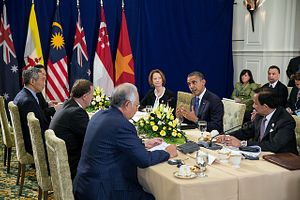The Trans-Pacific Partnership (TPP), a free trade agreement among 12 countries in the Asia-Pacific region, was concluded in October 2015. Southeast Asia is represented in the agreement by Brunei, Malaysia, Singapore and Vietnam. Now that the TPP negotiations have successfully concluded – something that many did not expect – the other nations of Southeast Asian must consider their options. The Philippines and Thailand have shown an interest in becoming part of the TPP, while Indonesia has officially declared its intention to join.
Should they rush to join?
The Trans-Pacific Partnership consists of 30 chapters, with coverage that is extensive by the standards of trade agreements. The TPP covers not only trade in goods, services and investment, but also areas ranging from investment to dispute settlement, and from labor to the environment.
In trade in goods, the TPP eliminates about 11,000 tariff lines, including some on sensitive agricultural products like rice, wheat, sugar, barley, beef, dairy products, and starch crops. In services, the TPP covers areas like banking, insurance, construction, logistics and accounting, travel and tourism, consulting, app and game development, and graphic design. In investment, it covers, among other things, the repatriation of funds and capital transfers, fair compensation in the case of expropriation, and prohibitions on performance requirements such as for local content or technology localization requirements.
In brief, some of the chapters in the TPP will reduce trade barriers, for instance by eliminating tariff and tariff-rate-quotas, which may boost trade among members. Some of the investment provisions provide better treatment for investors and thus may encourage more investment. Other chapters are debatable, at least from an economic point of view, and may see customers paying higher prices.
First, the TPP covers investor-state dispute settlement (ISDS). This is an instrument of public international law that grants an investor the right to use dispute settlement proceedings against a foreign government. Lori Wallach, director of Public Citizen’s Global Trade Watch, argues that it is inappropriate to elevate an individual investor or company to equal status with a nation-state to privately enforce a public treaty between two sovereign countries.
Second, the TPP may grant extensions to copyrights and patents, including patents on medicines that prevent the manufacture of generic medicines. Jeffrey Sachs, Joseph Stiglitz, and many NGOs claim that this will impose the aggressive pricing practices of big pharmaceutical multinational companies and unnecessarily extend copyright protections well beyond their social usefulness. This will lead to consumers paying for higher-cost patented medicines for longer than agreed in the Agreement on Trade-Related Aspects of Intellectual Property Rights.
The general suggestion for any potential member countries is to carefully study all 30 chapters, including all tariff lines, tariff rate quotas, rules of origins, ISDS, intellectual property rights provisions, and all annexes. It should start from Chapter 30, which consists of the clauses on open accession to new members. Would-be members should also carefully look at issues such as trade creation and trade diversion, investment formation and investment obliteration, employment creation and employment destruction.
Southeast Asian countries should also keep in mind two scenarios. In the first, the TPP is ratified by member countries, and even Korea and China join. After all, Korea claims it is a “natural partner” of the TPP, and China has said that it “always keeps an open mind toward the construction of systems that are in accordance with WTO rules and are helpful for promoting economic integration in the Asia-Pacific region.” In this scenario, trade in the Asia-Pacific will be profoundly altered.
In the second scenario, the TPP is not ratified by certain countries, most importantly the United States. For instance, Congress may see the “single undertaking” approach represented by the 30 chapters as too broad, with too many costs to swallow. This could create scope for an improvement in the agreement, while offering the potential for new members to have input.
Relatively small economies often use bilateral and regional agreements as a driving force for domestic reforms. In fact, whether the remaining Southeast Asian countries join or not, they could learn from the strengths of the TPP, ignoring the more dubious provisions, and proceed with reforms themselves.
After all, globalization in any form is still subservient to national interest, not the other way around.
Lili Yan Ing is an economist for Economics Research Institute for ASEAN and East Asia (ERIA) and a lecturer at University of Indonesia. The views expressed are her own.

































